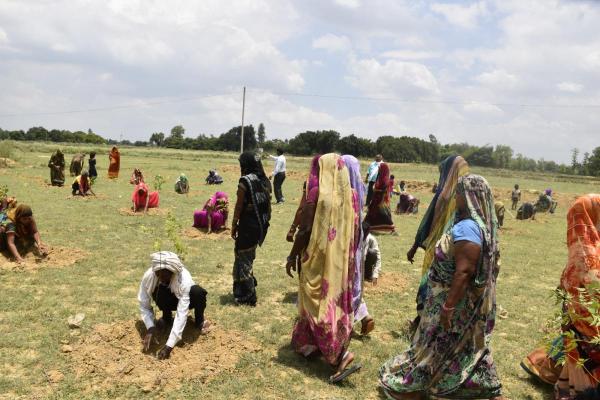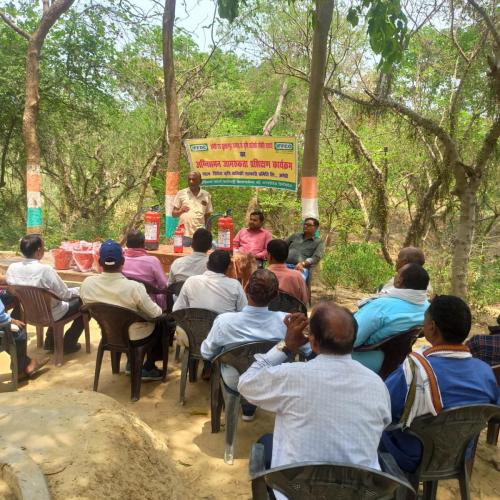The Indian Farm Forestry Development Cooperative (IFFDC) promoted by the Indian Farmers Fertilizer Cooperative (IFFCO) became the first Indian Cooperative in the Agro Forestry sector to get 78,000 Carbon Credits issued by VERRA, US for creating 189 ha forest on wastelands. VERRA is a nonprofit organization that operates standards in environmental and social markets, including the world's leading carbon crediting program.

Mr. S.P. Singh, Managing Director, IFFDC, India
On this World Environment Day, we are celebrating IFFDC’s achievements. Read this insightful conversation with Mr. S.P. Singh, Managing Director of IFFDC, to learn about IFFDC’s work, carbon credits, and their impact on local communities and sustainable development.
Q1. Congratulations on IFFDC being the first Indian cooperative in the agro-forestry sector to receive 78,000 Carbon Credits from VERRA! Could you provide an overview of this initiative of converting wastelands into forests that led to this achievement?
Thank you very much for the compliments. IFFDC came into existence formally in 1993 although its work had begun in 1986-87. The “Farm Forestry Project” on wasteland development in the states of Uttar Pradesh, Madhya Pradesh and Rajasthan started with the main objective to improve the degraded/ wastelands through farm forestry to increase forest cover, improve the environment, generate rural employment and provide fuel and fodder to the community.
IFFDC was promoted by IFFCO to replicate the “farm forestry cooperative model” on a larger area and increase the country’s forest for ecological balance. So far, IFFDC has promoted 152 Primary Farm Forestry Cooperative Societies (PFFCS) as its members and afforested more than 29,000 hectares of wasteland through these cooperatives. Landless and small & marginal farmers are members of these cooperatives with women having a stake of 34% in the membership.
In 1997, the Clean Development Mechanism (CDM) was created as part of the Kyoto Protocol which expanded the concept of carbon emissions trading to a global scale. It focused on the major greenhouse gases that cause climate change. Under this mechanism, developed countries can buy credits from projects in developing countries to meet carbon-neutral or net-zero targets. To impart the benefits of CDM to the members of forestry cooperatives, IFFDC started a pilot project on Carbon credits which was registered with VERRA in 2008.
Q2. What motivated IFFDC to venture into agro-forestry and undertake a project on wastelands? Are there specific UN Sustainable Development Goals (SDGs) that IFFDC aimed to address through this initiative?
IFFDC through its member forestry cooperatives is undertaking plantations on wastelands to increase green cover and conserve the environment. The tree species of long gestation periods such as Teak, Indian Rose Wood (Dalbergia sissoo) etc were planted to develop green forests on the wastelands. The society members do not get any economic returns from such tree species due to comparatively slow growth, long maturity periods and the state government bans on harvesting such species. Therefore, the forestry cooperative members started losing interest in developing wasteland plantations and detaching from the cooperative’s forestry-related activities. Therefore, IFFDC introduced the agro-forestry system in its plantation programme. Under agro-forestry the plantation is undertaken on cultivated land of farmers on their field boundaries and as intercropping. The species selected for raising plantations on farmers’ fields as agro-forestry are of short gestation periods with commercial value. Due to that, member farmers are now taking interest in undertaking plantations under the agro-forestry system.
Further, as of 2021, the total forest cover in India is 80.9 million hectares, which is 21.71% of the total geographical area and is less than the forest requirement of 33% of the geographical area for a balanced environment. The agro-forestry activities generate a source of livelihood for the marginalized rural community including women. The agro-forestry is also an option for increasing the farmers’ income. Most importantly, the forests are sequestrating carbon from the atmosphere which helps in mitigating climate change. These are factors that encourage IFFDC to undertake plantation every year.
Thus, IFFDC’s farm forestry project not only contributes to mitigating climate change but also helps generate additional sources of income for the farmers and ensures the sustainability of forestry cooperatives from the plantations raised on wastelands and marginalized lands. Out of the total 17, this project is addressing 8 SDGs. The developed forests are sequestrating atmospheric carbon to mitigate climate change which is addressing SDG – 13 “Climate Action”. The forest developed in a waterlogged area is now converted into a bird sanctuary. Wildlife and many new plant species and grasses have emerged in the developed forests which contributed to SDG – 15 “Life on Land”. The project contributes to SDG – 1 “No Poverty” as the plantation activities generate employment for the rural community which generates income for their families. IFFDC is undertaking fruit plantation under Agro-horti system as well which increased nutritive food availability in the project area addressing the SDG – 3 “Good Health & Well Being”. Further, IFFDC has promoted and nurtured more than 1,900 Self Help Groups (SHGs) with 19,529 members, of which 94% are women. These women members are generating income through various microenterprises and supporting their family’s livelihood which contributes to SDG – 5 “Gender Equality”, SDG – 8 “Decent Work and Economic Growth” and SDG – 10 “Reduce Inequalities”. IFFDC along with member forestry cooperatives and SHGs are endeavoring toward ecological restoration, economic growth and capacity building of the rural community, contributing to SDG – 17 “Partnership for the Goals”.

Plantation of trees
Q3. How does the process of obtaining carbon credits work, and what were the key criteria or standards set by VERRA for issuing these credits?
The carbon offset projects follow a rigorous development and assessment process in accordance with the highest standards and certification bodies. IFFDC is working closely with PFFCSs throughout the project lifecycle from feasibility studies, baseline data collection, preparation of project description document (PDD), GPS Mapping of the project sites, conducting validation audit of the project in terms of carbon credits generation, project registration with VERRA, sample plots preparation, measuring growth & development of the plantations, verification audit of the generated carbon credits, certification of the carbon credits, ongoing monitoring post-certification, fire fighting trainings for the forestry cooperatives and exploring the international market to sell the credits.
IFFDC started the project on a pilot basis for 189 hectares of area from 2008 to 2013. The carbon credit project was registered in April 2023 with VERRA and received 78,000 carbon credits under Verified Carbon Standards (VCS) in May 2023, for the period of 2008 to 2022 (first quarter). Out of which, 41,000 carbon credits have been sold in the international market resulting in revenue of Rs 67.20 million. Rs 15 million was issued to 11 forestry cooperatives and Rs 30 million to 120 farmers on whose land the plantation was done. The VCS Program is the world’s most widely used greenhouse gas (GHG) crediting program. It drives finance toward activities that reduce and remove emissions, improve livelihoods, and protect nature. Based on these board criteria, the VERRA has issued the carbon credits to IFFDC.
Q4. In creating a 189-hectare forest on wastelands, what kind of challenges did IFFDC face and how were they overcome? Were there any innovative or unique approaches used in this project?
IFFDC has been undertaking forestry on wastelands with community participation and forestry cooperatives since its inception. It has strong linkages and rapport with the rural community, therefore, no major challenges were faced in developing forests on wastelands. There were a few incidents of fires in the summer season in the plantation areas. To prevent such forest fires, two major steps have been taken. The fire protection trenches/ strips have been prepared in the forest area to seize the fire if such an incident occurs. Secondly, the forestry cooperative members were trained in firefighting by organizing practical trainings and providing firefighting equipment to them.

Firefighting Awareness Training
Q5. What impact does the issuance of 78,000 Carbon Credits have on IFFDC and its member farmers, both in terms of environmental sustainability and economic benefits?
The generation of carbon credits and its revenue has a very encouraging impact on IFFDC, its member cooperatives and the farmers on whose land the plantation is undertaken. The forestry cooperative societies and the members were made aware of the forestry-based carbon credits concept through stakeholder orientation workshops. A tri-party agreement amongst IFFDC, Forestry Cooperative and land-owner member farmers was undertaken on sharing the revenue of carbon credits.
Under the agreement, after the deduction of the expenses on the development of the carbon credit project including validation & verification audit fee, GPS Mapping, VERRA Fee etc. the revenue generated from the sale of credits is shared with Forestry Societies land-owner member farmers (50%), concerned IFFDC member Forestry Cooperative where the plantation is raised (25%), and IFFDC (25%). This project will generate carbon credit revenue for 30 years starting from 2008 to 2038 for all three stakeholders.
Now, the farmers are attracted towards developing more plantations to get revenue from carbon credits as it is a new income generation venture for them. However, the developed trees will always remain with them. They will not harvest trees under the carbon credit project which has the environmental benefits by increasing tree cover in the project area.
Q6. How does IFFDC plan to utilize or reinvest the carbon credits obtained? Are there specific projects or initiatives in the pipeline that align with the IFFDC’s commitment to sustainability?
IFFDC plans to utilize the carbon credit revenue in developing more carbon credit projects with the member forestry cooperatives. The cooperative societies will invest this revenue in plantation development and increase the area under plantations.
The achievement of IFFDC's Carbon Credit pilot project has served as an inspiring milestone, further bolstering its endeavours. IFFDC has since diligently devised and officially enlisted a second project with the VERRA Registry in Washington DC. This encompasses a plantation area spanning 455.25 hectares, meticulously cultivated between 2015 and 2023, across 30 PFFCS in Uttar Pradesh and 6 PFFCS in Madhya Pradesh. This initiative is expected to yield an annual production of 10,370 carbon credits, equating to a significant carbon sequestration of 10,370 tons. Over two decades, this is estimated to culminate in an impressive total of 2,07,447 carbon credits. Accredited auditors have completed the vital validation audit for carbon credit generation. As the project moves forward, the subsequent verification process will ensue, ultimately paving the way for the issuance of carbon credits by the VERRA Registry.
Q7. What advice or insights can IFFDC share with other cooperatives or organizations looking to engage in similar environmentally responsible initiatives and pursue carbon credits?
Cooperatives have a unique ability to efficiently aggregate and mobilize large numbers of people and resources at the community level to increase crop productivity and overall income by generating support in various activities related to agriculture, forestry and allied activities. The cooperatives may also focus on ecosystem services to develop resilience towards climate change. Activities such as agro-forestry, restoration of degraded forests, tree planting and intensive farming increase carbon sequestration, thereby generating carbon credits which may be another commodity that can be traded through the cooperative approach.
The cooperative marketing model fits nicely in carbon trading. Cooperatives have the potential to chip in to organize the smallholder farmers to take advantage of the carbon market, both voluntary and/ or compliance markets. Smallholder farmers do not know how to access carbon markets because of small-scale production. The Cooperative societies have the potential of bundling or stacking carbon credits into bigger volumes that fits the requirement of the market. Thus, cooperatives may act as aggregators who collect carbon credits from smallholder farmers and sell them in international markets or to private buyers through the voluntary market. Thus, the cooperative sector may play an important role in addressing the SDG - 13 “Climate Action”, effectively.



